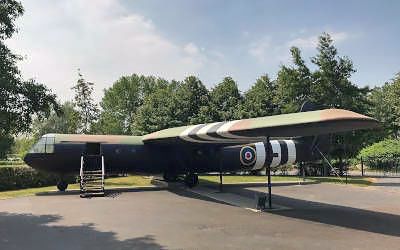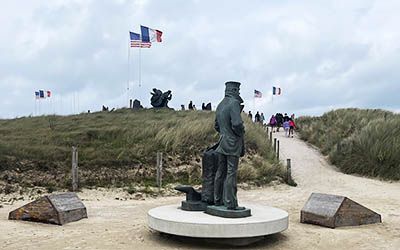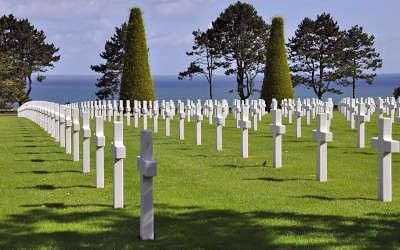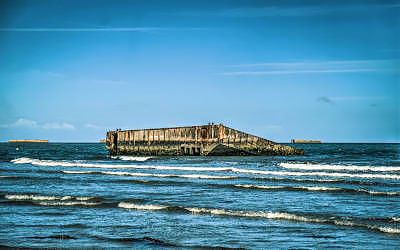In this blog, we guide you through Normandy, as we pay deep tribute to the heroes who made a significant impact on history. The coastline of Normandy became the stage for the largest amphibious invasion ever on 6th June 1944. Additionally, you can follow in the footsteps of the soldiers and explore the most impressive D-Day memorial sites, not only for the breathtaking views and picturesque villages, but primarily to uncover the deeply embedded roots of peace here.
These D-Day memorial sites are living proof of bravery, sacrifice, and determination. Moreover, heroes from many nations paved the way for peace in Western Europe. Leading up to the 80th anniversary of D-Day, we visited many remarkable locations, embarking on an emotional and impressive journey along beaches, museums, bunker complexes, and cemeteries. Through this journey, we gained a better understanding of the essence of freedom and peace.
In this blog ...
- Structure of the blog on D-Day memorial sites
- 6 June 1944: D-Day
- The five landing beaches of D-Day
- More information about D-Day memorial sites
- 80th anniversary commemoration of D-Day
- Map of D-Day memorial sites
- Frequently Asked Questions about D-Day memorial sites
- Other topics you may be interested in
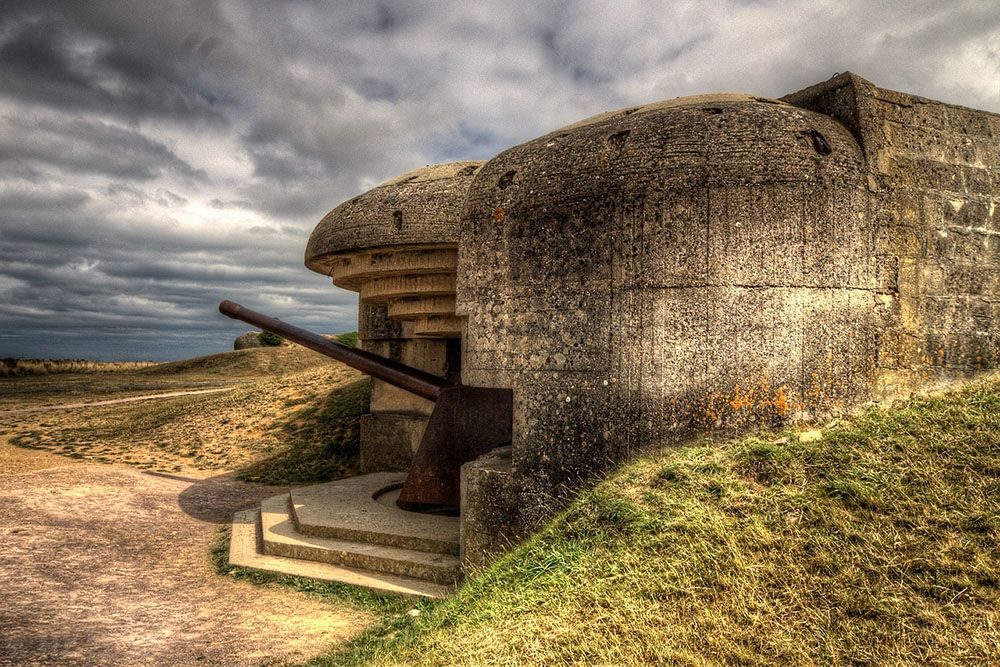
Structure of the blog on D-Day memorial sites
In this blog, we first provide background information about D-Day and the landing beaches. Subsequently, in several separate blogs (see the thumbnails below), we cover the most impressive memorial sites. These include museums, cemeteries, monuments, and special locations along the beaches, grouped by landing beach.
At the bottom of this blog, you will find a map showing the D-Day landing beaches and the described memorial sites.
The number of D-Day memorial sites in Normandy is plentiful. Consequently, we haven’t seen them all. Therefore, we conclude by providing tips on where to find information about other D-Day memorial sites.
D-Day sites at Juno and Sword Beach
The coastal villages of Graye-sur-Mer, Courseulles-sur-Mer, Bernières-sur-Mer, and Saint-Aubin-sur-Mer were the area with the codename Juno Beach in June 1944. Further to the east were the towns of Merville and Ouistreham, situated in...
D-Day sites around Utah Beach
Sainte-Marie-du-Mont on the Cotentin Peninsula in Normandy is known among cycling enthusiasts as a stage location of the Tour de France. In 2016, the British cyclist Mark Cavendish crossed the finish line here first. However, on June 6,...
D-Day sites around Omaha Beach
The beach between Sainte-Honorine and Vierville-sur-Mer is one of the most renowned beaches in the world. Not for its white sandy beach, surf, waves, and picturesque surroundings. No, this beach was the scene of the American invasion...
D-Day sites around Gold Beach
Arromanches-les-Bains, once a tranquil fishing village where those not involved in fishing farmed the fertile surrounding lands, became a beloved seaside resort by the end of the 19th century. Tourists admired its peaceful location,...
6 June 1944: D-Day
On 6th June 1944, under the codename Operation Overlord, the largest amphibious operation in history commenced, marking a turning point in World War II. The lead-up to D-Day was a meticulously planned operation, with the objective of establishing a firm foothold on mainland Europe and delivering a devastating blow to the Nazis. On 5th June, Allied aircraft bombed various German positions to weaken their defense, including the strategic Pointe du Hoc. However, success was not guaranteed. In the early morning of 6th June, the Allied troops began their historic landing, with thousands of young men losing their lives in the struggle for freedom and liberation.
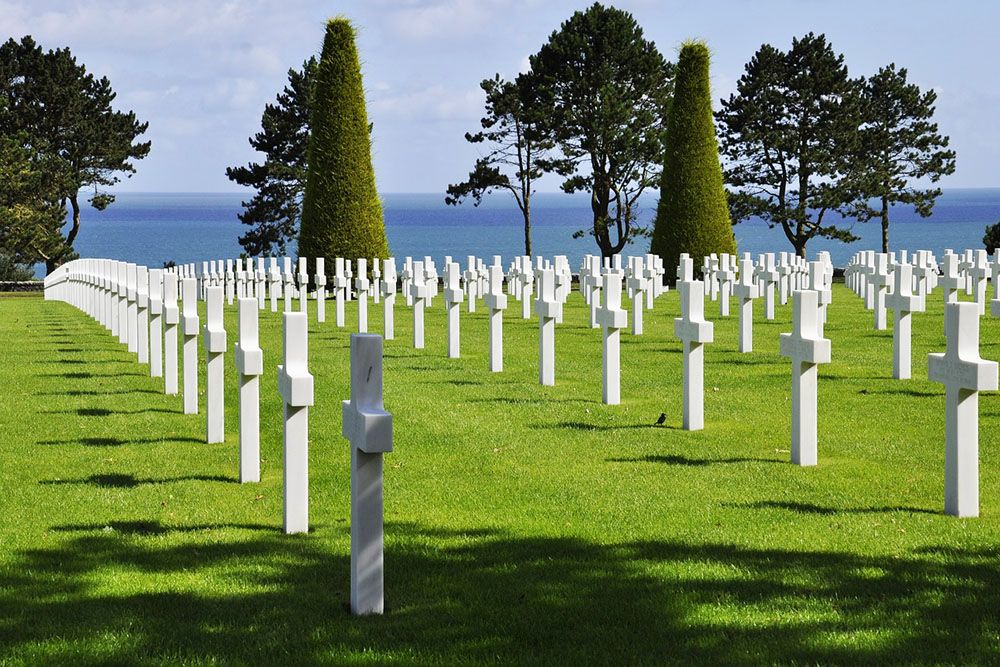
The five landing beaches of D-Day
On 6th June 1944, the Allied forces strategically selected five landing beaches on the Normandy coast as the frontline of liberation, based on various factors such as accessibility from England and the resistance of the German troops. While an attack in Normandy was less expected, the Germans had prepared for an attack in the Strait of Calais, where the distance from England to the continent is the shortest.
Utah Beach: Successful breakthrough in the West
Utah Beach, situated on the western flank of the invasion zone, witnessed a relatively successful landing. The German resistance was less than expected, allowing the American troops to quickly establish a strong foothold at Utah Beach and advance towards the important port city of Cherbourg. This led to the successful capture of sites at Utah Beach. » D-Day sites around Utah Beach.
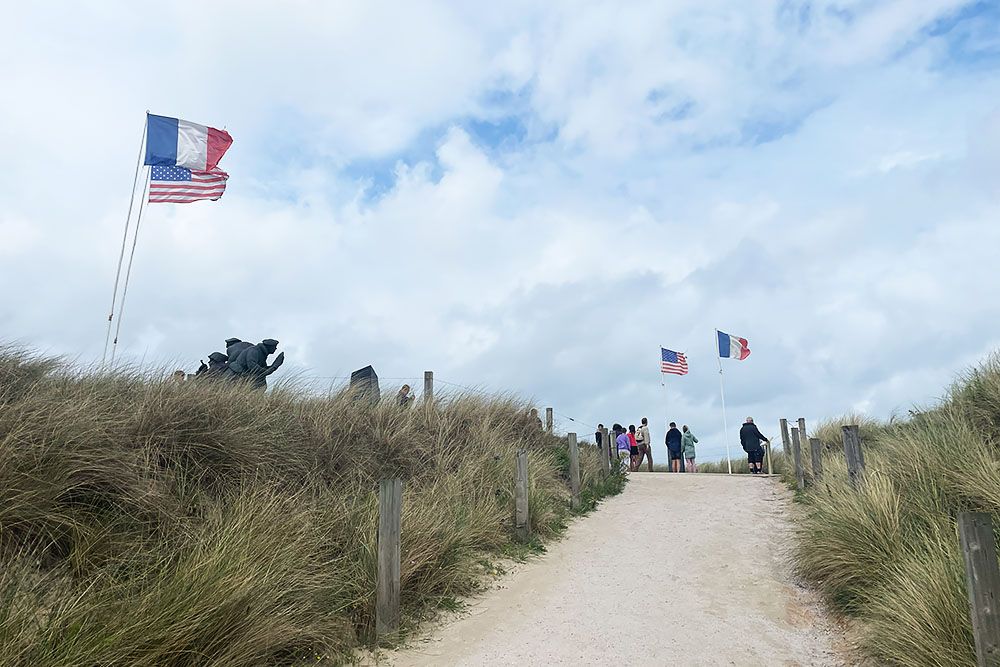
Omaha Beach: Liberation at the greatest cost
Omaha Beach became the scene of intense fighting. During the first hours, many young Americans lost their lives before even reaching the shore. Despite fierce resistance, the Allies ultimately succeeded in capturing this hard-fought beach. This resulted in the successful capture of sites at Omaha Beach. » D-Day sites around Omaha Beach.
Gold Beach: Key to progress
Strategically located between Omaha and Juno, Gold Beach served as a key position for connecting the Allied forces. The swift capture of this beach was essential for coordinating the advance. British troops were responsible for securing Gold Beach. This led to the successful capture of sites at Gold Beach. » D-Day sites around Gold Beach.
Juno Beach: Canada’s contribution
Canadian troops contributed to the success of D-Day through the capture of Juno Beach. Despite heavy resistance, the Canadians steadily made progress. This led to the successful capture of sites at Juno Beach. » D-Day sites around Juno Beach.
Sword Beach: Eastern pillar of liberation
Sword Beach, the eastern pillar of the invasion, was assigned to British troops. The Allies successfully liberated this beach, creating a crucial bridgehead for further advancement. This led to the successful capture of sites at Sword Beach. » D-Day sites around Sword Beach.
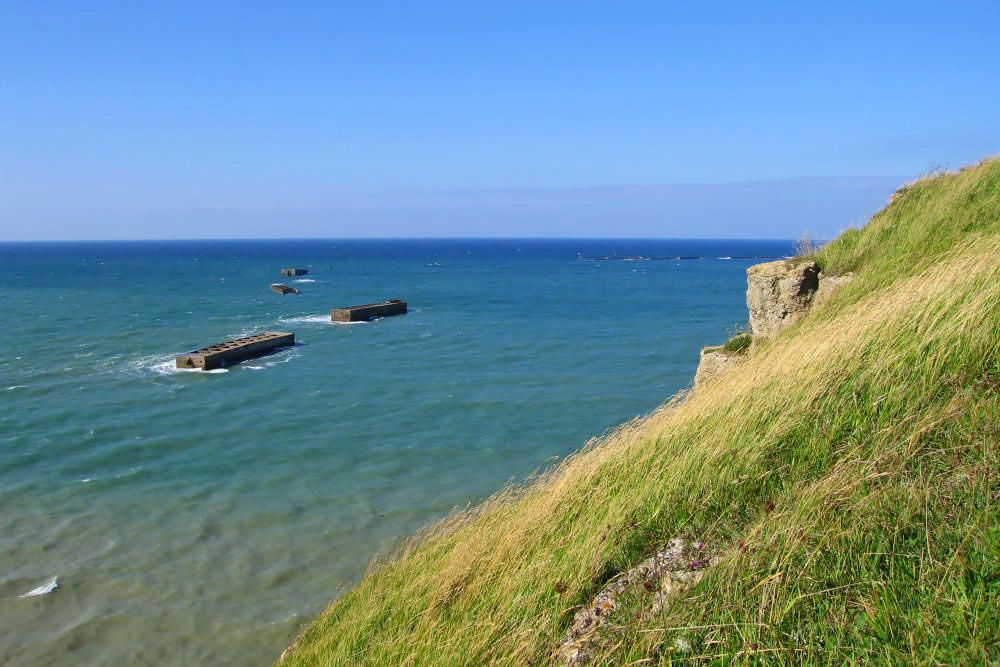
More information about D-Day memorial sites
This is just a small selection of interesting memorial sites. In Normandy, many more locations, both well-known and lesser-known, can be found. For an overview, visit: [URL]
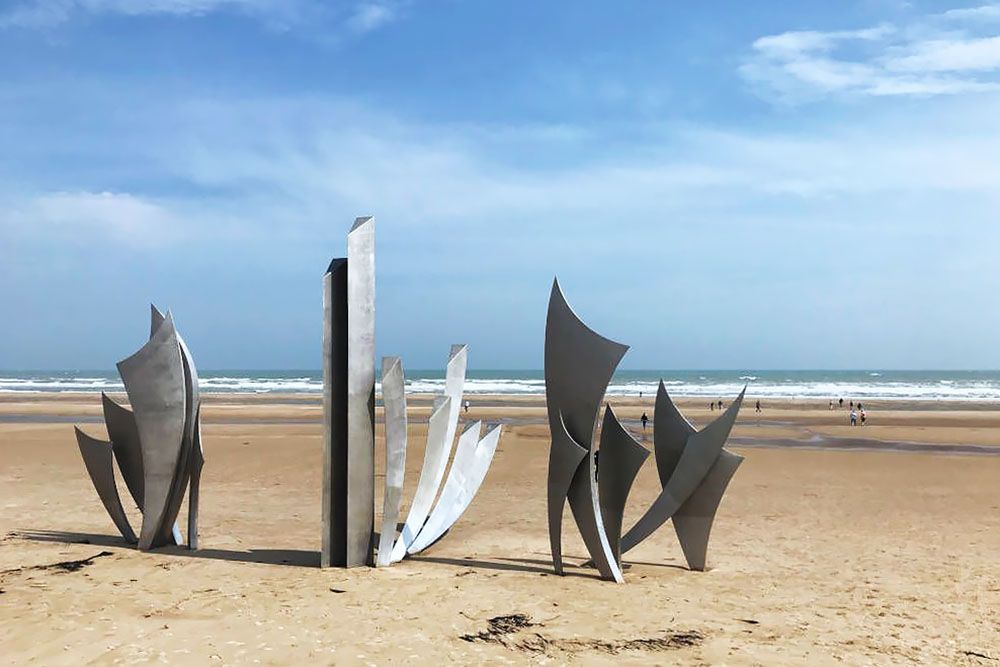
80th anniversary commemoration of D-Day
In 2024, it will be 80 years since the invasion of Normandy took place. This milestone will be extensively commemorated, with one of the highlights being the D-Day Festival Normandy. Festivities are not limited to and around 6th June. From 1st March to 1st October, the region will host numerous events. All information can be found on the D-Day Festival website.
Normandy is therefore an excellent destination for a short visit or longer holiday this year. Let’s not forget that the region boasts a wealth of natural beauty, picturesque towns and villages, historical and cultural heritage, and many other highlights. Along with the D-Day commemorative sites, they add colour to every holiday.
However, we advise against visiting D-Day locations on 6th June. Various commemorations will take place on that day at different locations, with leaders and dignitaries from around the world in attendance. The festivities are by invitation only, and extensive security measures will be in place. This means that many roads will be closed to traffic. It’s therefore better to choose another time to visit the monuments. Please remove this paragraph after 6th June.
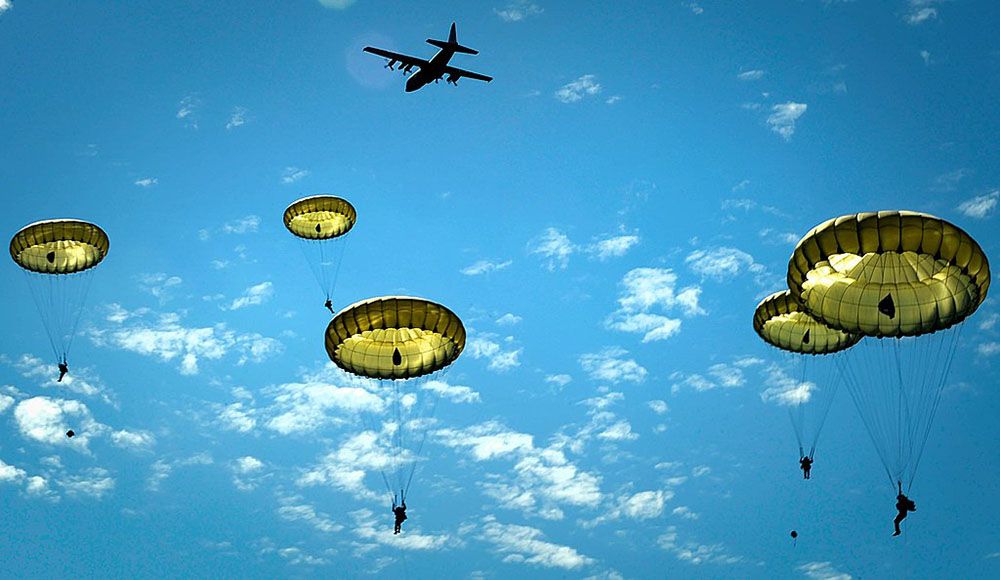
Map of D-Day memorial sites
Frequently Asked Questions about D-Day memorial sites
D-Day, or Decision Day, was the largest amphibious operation in history. The Allied forces planned to initiate the liberation of Western Europe through an invasion on the beaches of Normandy. This operation, codenamed Overlord, primarily involved soldiers from America, the UK, and Canada. Other countries that contributed to the invasion included Norway, Australia, Belgium, France, Greece, the Netherlands, New Zealand, and Poland.
The original plan was to execute the invasion on 5th June 1944, but due to unfavorable weather conditions, D-Day was postponed to 6th June 1944. The Allied leaders wanted optimal conditions for the invasion, and the weather played a crucial role. On 4th June 1944, meteorologists predicted a more favorable weather forecast for 6th June. Therefore, based on this forecast, the Allies decided to shift the invasion to 6th June.
D-Day marked the turning point in World War II. Thanks to the intense battles and despite significant losses, the Allies gradually conquered Normandy and liberated Paris. This dealt a major blow to the German occupiers. Thus, D-Day became the beginning of the end for the Nazis. The success of D-Day ultimately led to the liberation of all of Western Europe and the capitulation of Nazi Germany.
The coastline from Sainte Marie du Mont in the west to Ouistreham in the east was home to five invasion beaches. The largest amphibious operation in history took place at these five locations. The beaches were codenamed Utah Beach, Omaha Beach, Juno Beach, Gold Beach, and Sword Beach.
Normandy hosts numerous museums that highlight specific aspects of D-Day. These are not to be missed: Caen Memorial Museum in Caen, Utah Beach Museum, Arromanches Landing Museum, Airborne Museum in Sainte-Mère-Église, Second World War Museum in Quinéville, and Memorial of Civilian War Victims in Falaise.
To gain a comprehensive understanding of the lead-up to the war, preparations for D-Day, the course of the war thereafter, and the period after the liberation up to the Cold War, it is advisable to start with the Caen Memorial Museum. This provides an excellent historical perspective. Afterward, you can immerse yourself more intensely in the other museums and memorial sites.
There are 27 military cemeteries in the Normandy region. Victims who fell during D-Day and the subsequent battles have found their final resting place there. The most well-known and impressive one is located near Omaha Beach in Colleville-sur-Mer. This is the American cemetery, where thousands of Americans are laid to rest. The cemetery features a large monument with an immense bronze statue. The visitors' center provides detailed information about the military operations during D-Day.
Other notable cemeteries are the English cemetery in Bayeux (the largest English cemetery on French territory) and the German cemetery in La Cambe. It is a solemn place with crosses in dark colours.
Annually, various commemorative ceremonies take place on 6th June. Every five years, these are major events attended by many world leaders and dignitaries. Therefore, it is not possible to visit the main D-Day memorial sites in those anniversary years (2024, 2029, and beyond). During such years, numerous activities are planned throughout many months in Normandy.
From 1st March to 1st October, Normandy will host numerous events. All information can be found on the D-Day website of Normandy Tourism.
Yes, it is possible to reach the (most) D-Day memorial sites by public transport. Buses operate from the cities of Caen (in the east), Bayeux (in the middle), and Carentan (in the west) to the invasion beaches and other memorial sites. These three cities can be easily reached from Paris by train.
Apart from the invasion beaches, there are several picturesque villages and towns along the coast. For instance, Barfleur, located north of Utah Beach. This charming village offers a beautiful small fishing harbour, colourful half-timbered houses, and pleasant terraces along the promenade. Additionally, just slightly inland, you'll find interesting typical Norman towns that are definitely worth a visit. Consider Caen, a city known for its rich history and attractions such as the Mémorial de Caen, the Abbaye-aux-Hommes, and the Château de Caen. Also, don't miss Bayeux, a city with lovely streets to stroll through. The city's main attractions include the Cathédrale Notre-Dame and the Bayeux Tapestry. This gigantic 11th-century tapestry depicts the conquest of Normandy.
Furthermore, nature enthusiasts will find ample satisfaction in this part of Normandy. The Cotentin Peninsula is home to the large and unique nature park "Marais du Cotentin et de Bessin". This water-rich marshland is a habitat for a wide variety of birds. It also hosts many rare plant species, including several types of orchids.
Other topics you may be interested in
- On a cycling holiday along the Vélomaritime in Normandy
- Normandy: historical sights and beautiful nature
- Mont-Saint-Michel, iconic island near Normandy
- Côte d’Albâtre in Normandy | the nicest villages

